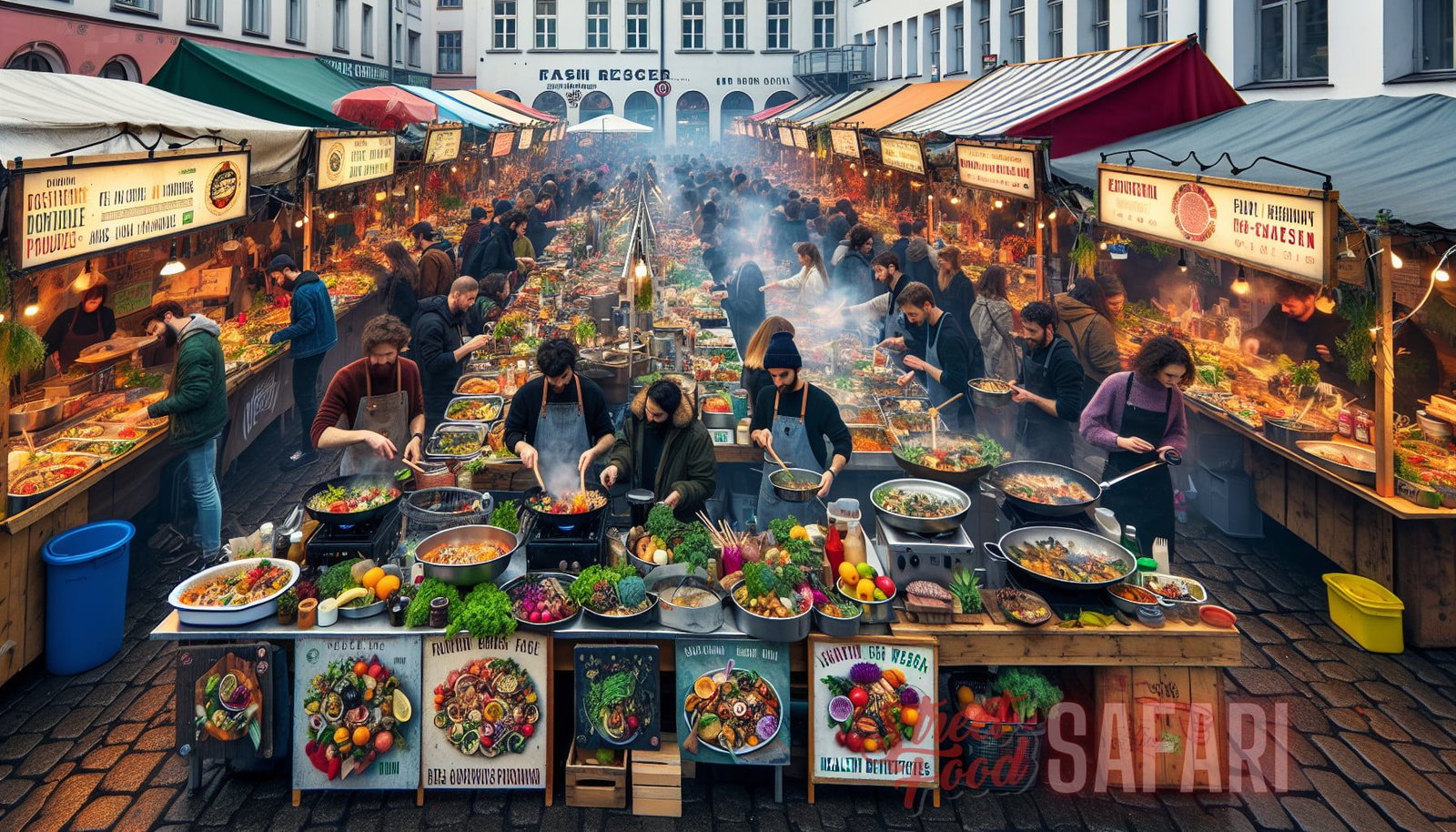Unraveling the Cultural Tapestry: Exploring the Dynamic World of Street Food Markets
Street eats have long been an integral part of global cuisine, offering a culinary adventure like no other. From bustling food stalls to vibrant food markets, street food is a cultural tapestry that reflects the soul of a city. And when it comes to experiencing the diverse flavors and traditions of a place, street food markets provide a window into the local culinary scene.
These vibrant markets offer a feast for the senses, where savory aromas fill the air, colorful food stalls beckon hungry travelers, and the sounds of sizzling grills and clinking cutlery create an unmistakable ambiance. Each street food market has its own unique charm, reflecting the culture, history, and local customs of its surroundings. In this article, we will delve into the world of street food markets, unraveling their dynamic nature and exploring the rich tapestry they offer to food enthusiasts.
History and Evolution of Street Food Markets
Street food has been around for centuries, serving as a quick and convenient way to satisfy hunger while on the move. The concept of street food markets can be traced back to ancient civilizations such as the Roman Empire and the markets of Asia. These early markets were vibrant hubs of trade and commerce, where local vendors sold their culinary creations to locals and travelers alike.
Over time, street food markets evolved and adapted to the changing needs and tastes of people. The rise of globalization and urbanization in the 19th and 20th centuries gave birth to a new wave of street food markets, catering to the diverse palates of a growing population. Today, street food markets can be found in nearly every corner of the world, each showcasing the unique flavors and traditions of its region.
One of the earliest recorded street food markets is the Borough Market in London, which dates back to the 12th century. This historic market has been a food lover’s paradise for centuries, offering a wide range of fresh produce, local delicacies, and international flavors. Its vibrant atmosphere and rich history make it a must-visit destination for any street food enthusiast.
The Role of Street Food Markets in Cultural Preservation
Street food markets play a vital role in preserving the cultural heritage of a place. They serve as a platform for local vendors to showcase their traditional recipes and culinary techniques, ensuring that age-old traditions and flavors continue to thrive. By patronizing these markets, visitors not only enjoy delicious food but also contribute to the preservation of the local culture.
These markets often serve as a melting pot of cultures, bringing together different ethnic communities and showcasing their diverse cuisines. It is in these vibrant marketplaces that one can explore the culinary traditions of various immigrant communities, from the Chinese night markets in Taiwan to the Arab markets in Jerusalem.
Furthermore, street food markets also provide economic opportunities for small-scale entrepreneurs. Many street food vendors come from humble backgrounds, and their businesses often serve as a means of livelihood for their families. By supporting these local vendors, visitors contribute to the local economy and help sustain these traditional trades.
The Global Street Food Movement
In recent years, the street food movement has gained momentum, with more and more cities recognizing the value of these markets in promoting tourism, supporting local businesses, and fostering cultural exchange. This movement has led to the establishment of permanent street food markets, food festivals, and even dedicated food streets in cities around the world.
One of the most notable examples of this movement is the borough of Brooklyn in New York City. Once a thriving hub of manufacturing and industry, Brooklyn has transformed itself into a vibrant culinary destination, with numerous street food markets and food halls showcasing the diverse flavors of the borough. The Brooklyn Flea Market and Smorgasburg have become iconic destinations for food lovers, attracting locals and tourists alike.
Another city that has embraced the street food movement is Singapore. The city-state is renowned for its hawker centers, which are large, open-air food courts that offer a wide variety of affordable street food. These hawker centers have become integral to Singaporean culture, and the city even has a dedicated organization, the National Heritage Board, to safeguard the heritage of these culinary institutions. Visitors to Singapore can experience a true gastronomic adventure by sampling dishes such as Hainanese chicken rice, laksa, and satay at these bustling hawker centers.
Trends and Innovations in Street Food Markets
Like any other industry, street food markets are not immune to trends and innovations. In recent years, several exciting developments have emerged, transforming the street food landscape.
1. Fusion Cuisine
Fusion cuisine has become a popular trend in street food markets, with vendors creating unique and unexpected flavor combinations. This blending of culinary traditions offers a fresh and exciting experience for adventurous food lovers. Whether it’s Korean tacos, Indian-inspired pizza, or Thai-infused burgers, fusion cuisine is pushing the boundaries of street food and creating new and delightful taste experiences.
2. Food Truck Culture
The rise of food trucks has revolutionized the street food scene, offering mobility and flexibility to vendors. Food trucks have become a common sight in many cities, bringing gourmet meals to office parks, street corners, and events. The food truck culture has also given rise to food truck festivals, where multiple vendors gather in one location, allowing visitors to sample a wide variety of dishes in a festival-like atmosphere.
3. Emphasis on Healthy and Sustainable Options

In response to the growing demand for healthier food options, many street food markets have started offering nutritious and sustainable choices. Vendors are incorporating more plant-based ingredients, using organic produce, and reducing the use of artificial additives. These changes not only cater to health-conscious customers but also contribute to a more sustainable and eco-friendly food industry.
Top Street Food Markets Around the World
With so many street food markets to choose from, it can be overwhelming to decide where to begin your culinary adventure. To help you navigate these vibrant markets, here are some of the top street food markets around the world:
1. Mercado de San Miguel – Madrid, Spain
The Mercado de San Miguel in Madrid is a food lover’s paradise, housed in a beautiful iron-and-glass structure dating back to 1916. Here, visitors can indulge in a wide variety of Spanish delicacies, from fresh seafood to traditional tapas. The market’s lively atmosphere and diverse culinary offerings make it a must-visit destination for anyone exploring Madrid’s food scene.
2. Jalan Alor – Kuala Lumpur, Malaysia
Jalan Alor is a bustling street in Kuala Lumpur that transforms into a vibrant street food market at night. This popular destination is known for its Malaysian and Chinese delicacies, offering a sensory feast of flavors. From char kway teow to satay, Jalan Alor is a must-visit for anyone craving authentic Malaysian street eats.
3. Marrakech Night Market – Marrakech, Morocco
The Marrakech Night Market, also known as Jemaa el-Fnaa, is a sensory overload of sights, sounds, and scents. This bustling square is home to a vibrant night market, where visitors can sample traditional Moroccan dishes such as tagine and couscous. The market also offers a wide variety of fresh fruits, aromatic spices, and refreshing mint tea.
4. Or Tor Kor Market – Bangkok, Thailand
Or Tor Kor Market in Bangkok is a paradise for food lovers, offering a wide variety of fresh produce and street food. This bustling market is known for its vibrant colors and flavors, with vendors selling everything from exotic fruits to flavorful curries. The market’s hygiene standards are excellent, making it a safe and enjoyable place to explore the flavors of Thai cuisine.
5. La Boqueria – Barcelona, Spain
La Boqueria is one of the most famous food markets in the world, located in the heart of Barcelona. This vibrant market has been in operation since the 13th century and offers a wide range of Spanish delicacies, from Iberian ham to fresh seafood. The market’s lively atmosphere and colorful displays make it a favorite destination for both locals and tourists.
These are just a few examples of the countless street food markets around the world, each offering a unique and unforgettable culinary experience. Whether you’re exploring the vibrant markets of Southeast Asia or indulging in the flavors of Europe, street food markets are sure to satisfy your cravings for authentic and delicious cuisine.
Conclusion
Street food markets are a vibrant tapestry that weaves together the flavors, traditions, and cultures of a place. They provide a platform for local vendors to showcase their culinary creations and ensure the preservation of age-old traditions. These markets serve as a melting pot of cultures, where visitors can explore the culinary heritage of a region and experience the vibrant atmosphere of a bustling marketplace.
With the rise of the global street food movement, these markets have become more than just places to grab a quick bite. They are now destinations in their own right, attracting food enthusiasts from around the world. From fusion cuisine to food truck festivals, street food markets are constantly evolving, offering new and exciting experiences for culinary adventurers.
So, the next time you find yourself in a new city, be sure to immerse yourself in the dynamic world of street food markets. From the sizzle of the grill to the tantalizing aroma of spices, these markets are a true celebration of food, culture, and community.
Related Articles
Continue your street food journey with our related articles:



